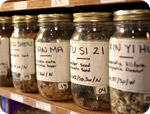
Treat Lyme Disease with Over-The-Counter Chinese Herbal Medicines
Wednesday, March 12, 2008 by: Luke J. Terry
Tags: lyme disease, health news, Natural News
- Hidden poison in your medicine and supplements: How phthalates in capsules are silently attacking your heart, thyroid, and hormones
- X-class solar flare sparks worldwide disruptions, with more storms expected as sunspot turns toward Earth
- Brushing with poison: Study finds toxic heavy metals in 90% of toothpaste brands, including those for children
- The truth about Benzyl Alcohol in beauty products
- DOJ targets controversial “Proximal Origin” study in push for scientific transparency
- HHS launches Generation Gold Standard, ushering in UNIVERSAL FLU VACCINE spearheaded by Bill Gates
- Australia’s vaccine cover-up: 35 died same day as COVID shot, but authorities ignored them
- Gaddafi's prophecy unfolds: How NATO's destruction of Libya fueled Europe's migration crisis
- EU court exposes secret Pfizer deal, orders von der Leyen and Bourla to reveal concealed texts
- OUTRAGE: Georgia shields pesticide giants from cancer lawsuits as corporate lobbying silences victims
- Renegade cardiologist joins MAHA, demands immediate halt to mRNA vaccines and overhaul of US health policies
- Breakthrough study links mRNA vaccines to irreversible female fertility loss
- FDA cracks down on unapproved fluoride drugs for kids as science exposes decades of deception
- Lard: A highly nutritious but misunderstood superfood
- Big Pharma's Dirty Secret: How Prescription Drugs Are Starving Your Body of Essential Nutrients
- Canada's COVID cover-up: Health officials swore secrecy to protect Trudeau from vaccine scandal
- When the storm brings spies: How a top weather app became an agent of surveillance
- Singapore's draconian vaccine mandate: Citizens face jail time for refusing FORCED medical procedures that do HARM
- Singapore's draconian vaccine mandate: Citizens face jail time for refusing FORCED medical procedures that do HARM
- WAR ON COGNITION: The Coordinated Assault on Your Brain and How to Defend Yourself Against Every Attack
- Big Pharma's Dirty Secret: How Prescription Drugs Are Starving Your Body of Essential Nutrients
- JESUS NEVER SPOKE ENGLISH: Historical facts on why the Bible you’re probably reading has been altered, redacted or hidden from much of its original meaning
- Canada's COVID cover-up: Health officials swore secrecy to protect Trudeau from vaccine scandal
- RED ALERT: Nuclear War Between India and Pakistan Could Trigger Global Catastrophe… full RISK ANALYSIS
- Gene-edited pork sneaks onto your plate: FDA quietly approves CRISPR pigs amid health and ethical concerns
- Silent catastrophe: COVID-19 vaccines linked to plummeting fertility rates, Czech data reveals
- Nicole Shanahan exposes RFK Jr.'s 'Broken Promise' - Claims Surgeon General Pick Casey Means is a 'Manchurian Asset' in shocking allegation
- EU embraces censorship over solutions as energy grid crises spark blackout fears
- Why All Government Officials and Big Tech CEOs Who Engage in Systematic Viewpoint Censorship Must Be ARRESTED, Prosecuted, and Sentenced to Life in Prison
- Texas governor threatens San Marcos over pro-ceasefire resolution, igniting free speech debate
- Polar ice rebounds confound alarmist predictions: New studies highlight climate's unpredictable dance
- Survival basics: 5 Dangerous locations to avoid during an EMP attack
- Health Ranger Report: Christopher Bjerknes challenges conventional narratives about world history
- Landmark study of 85 million reveals shocking surge in heart attacks, strokes, and sudden death following the notorious COVID-19 jab
- Spike protein found in stroke victims’ brains up to 17 months after injection, study reveals
- Virologist who endorsed HCQ for COVID-19 appointed to top pandemic post at HHS
- The Miraculous Healing Power of DMSO: Nature's Forgotten Cure for Cancer, Pain, and Regeneration
- Biblical truth: God will carry out a “cosmic reset” of Earth and destroy all human civilization with a series of extinction-level cosmic impacts known as The Seven Trumpets, Seven Bowls and Seven Seals
- URGENT REPORT: The China Import Embargo - What to Stockpile Now Before America Runs Out
- The Ultimate Survival Guide to Baking Soda: A Miraculous, Multi-Purpose Remedy for Health, Home, and Emergency Preparedness
- Widespread social and economic unrest: Steve Quayle issues urgent financial warning of imminent asset collapse in new interview with Mike Adams
- Aerosolized bioweapons? Strange “diploid biomasses” falling out of the sky in Florida captured under the microscope
- A call to preserve America’s future: “Defeating Big Government Socialism” by Newt Gingrich
- Stunning Visualization of the Seven Trumpets in the Book of Revelation
- Big Pharma launches “Vaccine Integrity Project” to combat Secretary Kennedy and keep 94 shots going into kids with mandates and liability protections
- World Economic Forum's current downfall exposes legacy of totalitarianism, financial fraud, and crimes against humanity
- Biden regime deployed over 600 grants to fund disinformation agenda, to silence the truth and stifle debate
- The Miraculous Healing Power of Green Tea: Unlocking the Potent Antioxidants That Big Pharma Doesn't Want You to Know About
- Russia escalates censorship war, targets over 200 VPN apps amid Google resistance
- Kiss Your Genetic Privacy Good-Bye! 23andMe Gets Green Light to Sell Your Intimate Genetic Details to Anyone They Want
- The unspoken truth about chemotherapy: These “treatments” create toxic time bombs in your body called CELL-KILLING PARTICLES
- A win for free speech: State Department SHUTS DOWN controversial disinformation office
- U.S. Government's Bio-War Against America: 15 Historical Medical Horrors Inflicted on the American People by the Government Itself
- U.S. demands U.K. protect FREE SPEECH, repeal hate speech authoritarianism, in latest trade deal negotiations
- Red Cross issues warning to stop blood plasma donations from vaccinated people
- Scientists confirm: GENIUS brain function can be spontaneously unleashed in humans without any apparent cause
- EPA advisor admits the agency is funneling billions to climate groups ahead of Trump’s return to White House
- HYSSOP: What research reveals about the health benefits of this ancient holy herb
- Two containers with completed ballots fall out of truck in Florida
- Newly released JFK files reveal Pentagon's role in creating Lyme disease and covid in the same lab
- Mike Adams releases country western hit single: Goin’ Back in Time is Comin’ Home
- Global leaders unite to clamp down on “misinformation” with UN-backed Cascais Declaration
- BREAKING: 2025 NDAA authorizes mandatory military draft of WOMEN across America… as Pentagon pursues global NUCLEAR war with both Russia and China at the same time
- I Want My Bailout Money – new song released by Mike Adams
- Michael Yon warns of a ZIONIST TAKEOVER in Trump’s second administration
- The Health Ranger releases “Vaccine Zombie” song and music video, using AI-animated zombies for the music video
- Ozempic and Wegovy weight loss drugs are injectable LIZARD VENOM PEPTIDES that may unleash a devastating wave of organ failure… side effects align with symptoms of SNAKE BITES
- BOMBSHELL: DNA testing kits are a SCAM to develop ethnic-specific bioweapons
- These 13 countries just signed an agreement to engineer a global FAMINE by destroying food supply
- Israeli soldiers accused of even more torture and abuse in the West Bank
- RFK Jr. clears key hurdle: Sen. Susan Collins backs controversial HHS nominee, signaling a new era for health policy
- Sermon 30: How Jesus reveals Caesar’s FAKE CURRENCY and FALSE AUTHORITY
Lyme disease is a clinical diagnosed constellation of symptoms caused by a related group of pathogens, chief among them borrelia bergdorferi. Lyme Disease (LD) became widely known in 1975 after a large number of children and adults near Lyme, Connecticut, began to show symptoms of rheumatoid arthritis. Juvenile rheumatoid arthritis is rare, and a team of researchers began to study the outbreak. It was discovered that all the children involved spent a great deal of time outdoors, and a high incidence of tick exposure was found. The pathogenic agent, a spirochetal bacterium, responsible for the disease, was discovered by a PhD biologist named Willy Bergdorfer. Thus this new pathogen was named for Dr. Bergdorfer: Borrelia Bergorferi. The group of researchers led by Dr. Bergdorfer found that LD is transmitted by a tick-borne vector to and from rodents and small mammals, deer, pets, and humans.
Lyme disease was first reported in California in 1978, and is now the most common tick-borne illness in California and the United States. Since Bergdorfer's work, other experts have discovered credible evidence of Lyme disease being transmitted via many more vectors, including mosquitoes, fleas, and even sexual contact, according to James Bowen, MD, of Portland, OR.
The complete clinical presentation of a patient with Lyme disease can present symptoms like many other diseases, including Multiple Sclerosis, Rheumatoid Arthritis, and many others. Because of this shape-shifting tendency, Lyme disease has been dubbed "the great imitator." However classical early-onset symptoms in humans may include pain, swelling in the joints, fever, headache, and fatigue—fitting a pattern that is described in the classical Shang Han Lun (Theory of Cold-Induced Damage), an ancient text in oriental medicine that has been used to successfully differentiate and treat illnesses for more than 1500 years.
The symptoms of Lyme disease usually show up days or weeks after a tick bite, though 50% of all LD patients cannot recall a tick bite, and it has been estimated that only 1-3% of all tick bites lead to LD. Several co-infections are commonly found along with LD, including erhlichosis, babiosis, and other forms of bacterium that are transmitted via tick or other insect bites.
Diagnosis in western medicine is made through identification of clinical signs and symptoms. No CDC-approved screening tests are accurate enough to be called definitive. Western diagnostic testing includes blood tests for IgG and IgM antibodies, such as ELISA and Western Blot, both showing poor sensitivity and specificity. Many experts in the field now believe that the borrelia pathogen assaults the B-lymphocytes, which are the components of the immune system responsible for making antibodies. When the antibody-producing cells are impaired, the immune system is blinded to the pathogens — and so are any diagnostic tests looking for antibodies. This mechanism may explain why many patients, both known Lyme carriers and those whose Lyme status is unknown, suffer from arthritic symptoms closely resembling those of Rheumatoid Arthritis or Lupus, yet not antibodies for Lupus or RA are found.
Thus the diagnosis must be made from looking at history, taking symptoms and general patterns into account. Diagnosis is additionally hampered by the co-infection factor, which may create a host of other sometimes strange symptoms.
The LD pathogen slowly makes its way through the body, the longer it remains in the body, the more severe the infection. The severity of the infection is categorized by western practitioners in one of three categories related to its progression in the body — early disseminated, late disseminated, and chronic. The disease is most treatable early in the progression. Standard western care includes immediate treatment with quinolone or cephalosporin antibiotics for a minimum of 6 weeks.
Mainstream western medicine treatment, limited to antibiotic treatment, commonly fails to provide relief or cure, and often results in worsening of the infection due to the side effects of the antibiotic therapy. Chronic LD has proven to be a very difficult infection to cure. End-stage patients can be severely neurologically compromised, and may resemble neurosyphilis in its clinical presentation: dementia, confusion, memory loss, delusions, and, eventually, complete neurological breakdown. This makes sense, because Borrelia Bergdorferi is in the same order as syphilis, the spirochaetalis order. Spirochetes are characterized by a flexible, spiral shape, not unlike a drill bit.
With so many factors involved, LD is an incredibly complex infection to describe, let alone to treat, and it is beyond the scope of this paper to describe in detail the unusual life cycle and characteristics of the organism that make it so difficult to treat with western medicine. The prognosis according to Traditional Oriental Medicine, or TOM, is much rosier, and demonstrates the power and optimism of this 5000-year old system of medicine. TOM has had much success treating both syphilis and leptospirosis, two cousins of Lyme disease. All three bacterium belong to the spirochete family. There is a large body of evidence demonstrating effective TOM herbal approaches to treating treponema palladium, and leptospira interogans, responsible for syphilis and leptospirosis, respectively.
Syphilis kills many thousands of people each year, though treatment with both western and oriental medicine effects a cure. Leptospirosis, from the Leptospira, is spirochetal infection transmitted to humans via flies, mosquitos and other insects, from pigs and other livestock. The symptoms of leptospirosis approximate those of Lyme disease, presenting with headache, severe muscle aches, chills, fever, and conjunctivitis, with the severe form known as Weil's disease causing hemorrhages, jaundice, and kidney and liver dysfunction.
Though there is little direct evidence of TOM success treating LD, clinical experience and success in treating other spirochetes demonstrates the strong potential of Oriental Medicine for effecting a cure for Lyme disease patients. Subhuti Dharmananda, PhD describes how early-stage disseminated LD follows a classic Shang Han Lun pattern. He also portrays the Lyme disease progression as one that fits the stages documented in the Shang Han Lun, with jaundice and meningitis both demonstrating severe and deeply penetrated pathogenic influence.
Bob Flaws, Dipl.OM, describes a progression in three stages; in the initial stage, LD is categorized as huo dan, or Fire Toxin, with Gan Mao, or contraction-encroachment, which are the flu-like initial symptoms. The initial pattern, then is one of damp heat & evil toxin entering the body. At this stage the immune system, called "the righteous qi" in traditional oriental medicine, still mounts a strong response. Traditional doctors would expect to see a red tongue with a slimy or greasy yellow tongue coating, and a floating, rapid pulse, along with the previously mentioned musculoskeletal symptoms.
The second stage, according to Flaws, is one of heat toxins with righteous qi vacuity. Thus the pathogen is stronger than in the first pattern, and the body somewhat weaker. The tongue in this stage would be less red, and more swollen, signifying more spleen xu. The pulse may be surging, indicative of more floating, unsupported yang energy as the yin is slowly consumed in the process of fighting the pathogen. Reiterating earlier, it is important to catch this disease as early as possible, as the longer it remains unchecked in the body, the more it damages the body's resources.
This is evident in Flaw's description of the deepest stage, one of profound qi, blood, and yin deficiency. Signs and symptoms would include extreme fatigue and loss of strength, tinnitus, low back pain, knee pain and swelling, dry mouth and throat, five-centers heat, malar flushing, hair loss, memory loss, confusion, and torpor.
This complicated clinical picture requires the deft use of herbs. The patient experiences both strong excesses (the pathogen), and potentially deep immune system deficiencies. Thus the treatment may be best approached with custom-blended medicinals. However, due to reasons of cost and convenience, commercially available, pre-prepared herbal supplements, or "patent" preparations may supplement or substitute for custom-blended powdered or raw herb formulas.
To begin with, a list of herbs that have been found to be medically effective against various spirochetes including borrelia bergdorferi is as follows: Coptis (huang lian), Scute (huang qin), Phellodendron (huang bai), Forsythia (lian qiao), Isatis root (ban lan gen), Isatis leaf (da qing ye), Andrographis (chuan xin lian), Smilax Glabra(tu fu ling), Asploidis (zhi zi), and Artemesia Annua (qing hao). Of these herbals, all are strong heat-clearing herbs with well-demonstrated antibacterial qualities. Chief among this group is artemesia annua (qing hao), showing an incredible effectiveness against malaria, another insect-born, though very different pathogen. In particular, an active ingredient called arteanuin is used alone as a western treatment for malaria. Many malaria experts believe this "drug" combats malaria more effectively than any man-made drug currently available.
This herb is readily available as a concentrated patent formula (Health Concerns, Artestatin). Others such as Forsythia (lian qiao), Isatis roots & leaves (ban lan gen & da qing ye), and Andrographis (chuan xin lian), are well-demonstrated against leptospirosis, and are readily available in balanced patent formulas. Of all of the above listed herbs, the best single herb is probably tu fu ling. This herb, Smilax Glabra, is perhaps the most gentle, most neutral and least damaging to the body. The "atmospheric qualities" of Smilax Glabra, or the way that the herb affects the body's condition globally, are categorized as sweet and neutral, meaning it is both gentle and nourishing. Smilax has shown to be profoundly effective against both leptospirosis (in large clinical trials) and against LD (by clinical experience). Unfortunately, there are few if any commercial preparations of Smilax Glabra, despite its profound effectiveness and mild nature. It appears that Smilax Glabra is underappreciated as a medicinal agent.
In the realm of patents, for acute phase, massive doses of Yin Qiao San are appropriate, as it contains Forsythia (lian qiao), and its usage fits the initial pattern of disease. Far East Summit's alcohol preparation would be an excellent choice, as the alcohol would drive the medicine into the channels and tissues. In addition, Artestatin from Health Concerns presents itself as a very effective medicinal agent, as its concentration and aromatic preservation are excellent. It also contains Coptis (huang lian,) and a number of balancing herbs, too long to be listed here, to balance the cold, draining qualities of Artemeseia (qing hao) and Coptis (huang lian).
In the early stage, this may be enough to arrest the development of the LD pathogen and cure the disease. If symptoms are still developing, another more tonifying formula, one which still contains a strong complement of the heat-clearing antispirochetal herbs, would likely result in much better clinical outcomes. Specifically, Astra Isatis from Health Concerns contains plenty of tonics for qi, blood, yin, and yang, in addition to its chief herbs, Isatis (ban lan gen and da qing ye). This formulation derives its punch from using the roots and leaves of the Isatis plant.
A compelling body of evidence exists demonstrating the significant potential of tu fu ling, or smilax glabra, also known as sarsparilla, in treating spirochetal diseases. It is the author's hope that manufacturers of quality Oriental herbal products will notice this market opportunity, and create a product to serve the many patients suffering from Lyme disease and its coinfections.
References:
National Institutes of Health, 2003. Lyme Disease: The Facts, The Challenge, NIH Publication # 03-7045, p. 3
Sutter-Yuba Mosquito and Vector Control District, Lyme Disease, online at: (http://sutter-yubamvcd.org/Lyme%20Disease.as...)
(www.samento.com.ec/sciencelib/medmain.html)
Dharmananda, Subhuti, PhD, Lyme Disease: Treatment with Chinese Herbs, Institute of Traditional Medicine, online at: (http://www.itmonline.org/arts/lyme.htm)
(www.neuraltherapy.com/LymeALookBeyond6.pdf)
Burrascano Jr., Joseph J. MD, September 2005. Advanced Topics in Lyme Disease, p. 4-5.
Flaws, Bob, and Sionneau, Phillipe, 2005. Treatmentof Modern Western Medical Diseases with Chinese Medicine, Blue Poppy Press. P. 329-332.
William Morris, OMD. Personal correspondence, and personal experience.
Gaeddert, Andrew, 2006. Health Concerns Clinical Handbook, 4th Edition, p. 45-46.
(http://www.rain-tree.com/sarsaparilla.htm)
About the author
Luke practices acupuncture, Oriental & natural medicine, and conducts wellness retreats in the mountain resort community of Breckenridge, Colorado.He sees clients at Sacred Tree, an integrative healthcare & wellness spa, located at the base of Peak 8 at Blue Sky.
Visit us at http://www.sacredtree.com
Lyme disease at FETCH.news
Get independent news alerts on natural cures, food lab tests, cannabis medicine, science, robotics, drones, privacy and more.
Take Action: Support Natural News by linking to this article from your website
Permalink to this article:
Embed article link: (copy HTML code below):
Reprinting this article:
Non-commercial use OK, cite NaturalNews.com with clickable link.
Follow Natural News on Facebook, Twitter, Google Plus, and Pinterest
Science News & Studies
Medicine News and Information
Food News & Studies
Health News & Studies
Herbs News & Information
Pollution News & Studies
Cancer News & Studies
Climate News & Studies
Survival News & Information
Gear News & Information
News covering technology, stocks, hackers, and more



"Big Tech and mainstream media are constantly trying to silence the independent voices that dare to bring you the truth about toxic food ingredients, dangerous medications and the failed, fraudulent science of the profit-driven medical establishment.
Email is one of the best ways to make sure you stay informed, without the censorship of the tech giants (Google, Apple, Facebook, Twitter, YouTube, etc.). Stay informed and you'll even likely learn information that may help save your own life."
–The Health Ranger, Mike Adams












































